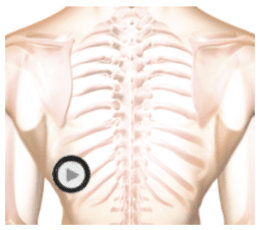Voice high frequencies are more readily transmitted to the chest wall in abnormal lungs as compared to normal lungs.
Ask the patient to whisper '1-2-3' several times while auscultating across the chest walls. The lung area is abnormal if the '1-2-3' sound is understood. This is the abnormal '1-2-3'.
Compare this sound to the recording found in the Whispered Pectoriloquy - Normal lesson.
Whispered Pectoriloquy - Abnormal Sounds


Half Speed Whispered Pectoriloquy - Abnormal Sounds


Technique

The patient's position should be sitting.
Auscultation Tips for Whispered Pectoriloquy - Abnormal
Features:Ask patient to whisper 1-2-3 several times. Auscultate across chest walls. Abnormal if 1-2-3 sound is understoodSound Wave
Authors and Sources
Authors and Reviewers
- ECG heart rhythm modules: Thomas O'Brien.
- ECG monitor simulation developer: Steve Collmann
-
12 Lead Course: Dr. Michael Mazzini, MD.
- Spanish language ECG: Breena R. Taira, MD, MPH
- Medical review: Dr. Jonathan Keroes, MD
- Medical review: Dr. Pedro Azevedo, MD, Cardiology
- Last Update: 11/8/2021
Sources
-
Electrocardiography for Healthcare Professionals, 6th Edition
Kathryn Booth and Thomas O'Brien
ISBN10: 1265013470, ISBN13: 9781265013479
McGraw Hill, 2023 -
Rapid Interpretation of EKG's, Sixth Edition
Dale Dublin
Cover Publishing Company -
EKG Reference Guide
EKG.Academy -
12 Lead EKG for Nurses: Simple Steps to Interpret Rhythms, Arrhythmias, Blocks, Hypertrophy, Infarcts, & Cardiac Drugs
Aaron Reed
Create Space Independent Publishing -
Heart Sounds and Murmurs: A Practical Guide with Audio CD-ROM 3rd Edition
Elsevier-Health Sciences Division
Barbara A. Erickson, PhD, RN, CCRN -
The Virtual Cardiac Patient: A Multimedia Guide to Heart Sounds, Murmurs, EKG
Jonathan Keroes, David Lieberman
Publisher: Lippincott Williams & Wilkin)
ISBN-10: 0781784425; ISBN-13: 978-0781784429 - Project Semilla, UCLA Emergency Medicine, EKG Training Breena R. Taira, MD, MPH
-
ECG Reference Guide
PracticalClinicalSkills.com
Whispered Pectoriloquy - Abnormal | #151